How do you sum output of 4 channels of BTL class D amps onto one resistor? The squarewave integration happens in the air with pressure waves. There may be built in phase shifts to allow acoustic signal to sum and be time aligned. I doubt electrical signals without drivers will be time aligned.
Probably have to go outdoors on a quiet day.
Probably have to go outdoors on a quiet day.
xrk971,
Could it be good idea do a live squarewave bench with DATS for your soundcard by loop it, then if it pass okay then put miniDSP in loop with neutral setting of course, and lastly with a resistor divider at output put your power amps in loop too. This would once for all reveal if any of those devices pass clean square waves as we had supposed they will and we will then know its a acoustic problem unless one of them fail. I don't know circuit schematics for your digital amps, but know one gotta be carefull if a amp is bridged it is virtual floating on negative speaker terminal and this can give trouble when connected in a loop with amps real ground. You can use DATS generator shifting between different square wave frq points within audio bandwidth or over your Trynergy thread there is links for square wave sweeps that both Legis and bwaslo shared there.
Could it be good idea do a live squarewave bench with DATS for your soundcard by loop it, then if it pass okay then put miniDSP in loop with neutral setting of course, and lastly with a resistor divider at output put your power amps in loop too. This would once for all reveal if any of those devices pass clean square waves as we had supposed they will and we will then know its a acoustic problem unless one of them fail. I don't know circuit schematics for your digital amps, but know one gotta be carefull if a amp is bridged it is virtual floating on negative speaker terminal and this can give trouble when connected in a loop with amps real ground. You can use DATS generator shifting between different square wave frq points within audio bandwidth or over your Trynergy thread there is links for square wave sweeps that both Legis and bwaslo shared there.
My netbook used for measurements with REW has no mic input jack. My mic is USB only. So cannot do loop back. I suppose I can use my 18 ch pro mixer and mix 4 channels of amp output (they are all buffered) at low volume. Then take mixed signal and find way to digitize it somewhere - maybe DATs as the oscope. My desktop has a fried mic input from an impedance test went awry.
I think easier to take it outside. Then that will be the real truth.
Class D BTL outputs cannot be tied together - they will short the amp and it will go into self protect and shut down.
I think easier to take it outside. Then that will be the real truth.
Class D BTL outputs cannot be tied together - they will short the amp and it will go into self protect and shut down.
xrk971,
Okay sorry your input is fried. Think better be carefull feeding mixer and start up with some serial resistors first. If at some time you will do the square wave loops for confirmation the devices then when at it and cabled it can be neat to run Rightmark Audio Analyzer which will give you distortion profiles, S/N ratios and dynamic range for DUT and think is nice to know data for ones gear if it keeps up to the promised specs.
Okay sorry your input is fried. Think better be carefull feeding mixer and start up with some serial resistors first. If at some time you will do the square wave loops for confirmation the devices then when at it and cabled it can be neat to run Rightmark Audio Analyzer which will give you distortion profiles, S/N ratios and dynamic range for DUT and think is nice to know data for ones gear if it keeps up to the promised specs.
BTL outputs
@ xrk971
No you can't connect the outputs together like that, but you don't need to. See my screenie for how you could safely do it. Make sure you ONLY feed around 1 Volt into the resistors, so start off with the Amp gains on Zero & measure the outputs as you slowly increase them to be sure. Also Feed the Amps with sensible signals too.
As All the equipment should be earthed, the fact that the Mixed outputs wire isn't shown with a direct earth connection to the Mixer etc, shouldn't matter ! But you could use screened cable for the mixer input, & ONLY connect the screen to ONE of the Amps earths, but leave the other end of the screen to the mixer UNCONNECTED.
I've just shown 2 x BTL Amps connected, but you can connect more. Duplicate the resistors on more Amps as on Amps 1 & 2, & connect the 1K's together @ the central point.
@ xrk971
No you can't connect the outputs together like that, but you don't need to. See my screenie for how you could safely do it. Make sure you ONLY feed around 1 Volt into the resistors, so start off with the Amp gains on Zero & measure the outputs as you slowly increase them to be sure. Also Feed the Amps with sensible signals too.
As All the equipment should be earthed, the fact that the Mixed outputs wire isn't shown with a direct earth connection to the Mixer etc, shouldn't matter ! But you could use screened cable for the mixer input, & ONLY connect the screen to ONE of the Amps earths, but leave the other end of the screen to the mixer UNCONNECTED.
I've just shown 2 x BTL Amps connected, but you can connect more. Duplicate the resistors on more Amps as on Amps 1 & 2, & connect the 1K's together @ the central point.
Attachments
For me, not having analog input would drive me totally crazy.
None the less, without it you've produced a remarkable alignment for a complex setup with USB microphone.
I've tested every element in my signal paths; biggest differences are high pass filtering, primarily from coupling capacitors. Typical results show slightly drooping square waves that are readily corrected using convolution with time reversed IIR filters.
Microphone response is next square wave killer in measurement chain. Best I've studied this is with small sealed coupler as described here: http://www.artalabs.hr/AppNotes/AP5_MikroMeasChamber-Rev03Eng.pdf. This combined with multiple microphone referencing by substitution garners enough information for me to proceed with confidence; my used Earthworks OM-1 microphones show virtually no change in performance from original calibration charts that came with the matched pair.
Filters that I've measured produced with DCX2496, DEQ2496 and miniDSP 10x10 HD all perform exactly as they should.
Acoustic output of drivers is all that matters. Without timing reference in REW, measurement of all three drivers running together, and individual drivers measured running solo allow for shifting time base of solo drivers such that they match when summed to get the all in one result, thus revealing timing info. Tedious but effective, typically leave tweeter with peak at t=0 and shift other driver time bases to get phase and amplitude match to the all in one measurement. From here it is easy to predict results for modified delays used with miniDSP. Likewise model of electrical filters may be studied in finding optimal delays for targets.
With IR-1 and IR-2, much is left to be desired with frequency response in my book; I doubt that in blind comparison that it would rank with reference monitor project or the TC9FD setups from your previous comparison threads.
-----
For .mdat that you so kindly provided me for first round comparison, you've applied microphone calibration in both microphone field and in soundcard calibration field; this is not correct.
The numerous distortion plots you have put up show marked similarities >3kHz; suggestive to me that UMM-6 microphone has IMD issues; I've explored IMD with ECM8000 in response to posting of results with this model by PMA using 19kHz and 20kHz played through separate speakers that shows significant 1kHz difference component. OM-1 shines on this.
Phase plot for your microphone calibration file rolls off sharply above 5kHz; this fits in with distortion plots and is telling of microphone's internal circuit's bandwidth limitations.
None the less, without it you've produced a remarkable alignment for a complex setup with USB microphone.
I've tested every element in my signal paths; biggest differences are high pass filtering, primarily from coupling capacitors. Typical results show slightly drooping square waves that are readily corrected using convolution with time reversed IIR filters.
Microphone response is next square wave killer in measurement chain. Best I've studied this is with small sealed coupler as described here: http://www.artalabs.hr/AppNotes/AP5_MikroMeasChamber-Rev03Eng.pdf. This combined with multiple microphone referencing by substitution garners enough information for me to proceed with confidence; my used Earthworks OM-1 microphones show virtually no change in performance from original calibration charts that came with the matched pair.
Filters that I've measured produced with DCX2496, DEQ2496 and miniDSP 10x10 HD all perform exactly as they should.
Acoustic output of drivers is all that matters. Without timing reference in REW, measurement of all three drivers running together, and individual drivers measured running solo allow for shifting time base of solo drivers such that they match when summed to get the all in one result, thus revealing timing info. Tedious but effective, typically leave tweeter with peak at t=0 and shift other driver time bases to get phase and amplitude match to the all in one measurement. From here it is easy to predict results for modified delays used with miniDSP. Likewise model of electrical filters may be studied in finding optimal delays for targets.
With IR-1 and IR-2, much is left to be desired with frequency response in my book; I doubt that in blind comparison that it would rank with reference monitor project or the TC9FD setups from your previous comparison threads.
-----
For .mdat that you so kindly provided me for first round comparison, you've applied microphone calibration in both microphone field and in soundcard calibration field; this is not correct.
The numerous distortion plots you have put up show marked similarities >3kHz; suggestive to me that UMM-6 microphone has IMD issues; I've explored IMD with ECM8000 in response to posting of results with this model by PMA using 19kHz and 20kHz played through separate speakers that shows significant 1kHz difference component. OM-1 shines on this.
Phase plot for your microphone calibration file rolls off sharply above 5kHz; this fits in with distortion plots and is telling of microphone's internal circuit's bandwidth limitations.
3116 has dropping phase from 1000hz because own outputfilter, ~20 degrees at 10khz. If your inputcapacitance seen by tpa3116 positive and negative side differs, you have additional bigger phase problem. (Negative input capacitance to gnd compared to capacitance from befor dsp or source output capacitor to past 3116 positive input capacitor) Tina/spice can show difference.
I saw this thread and found the concept interesting. I have no technical knowledge at all so have to rely entirely on my ears when experimenting.
I have some old speakers that I use for playing - Chinese 12"/Celestion HF1300/KEF T27 as super tweeter - that sound pretty good. In the spares box is a pair of 5" Taiwanese specials from some Aiwa speakers, so I just wired them in series on some open baffles and plugged them in.
Surprising improvement in overall clarity - further experiments are indicated. The mid is acting as a full range of course so some sort of frequency shaping might be in order.
It might just mean that I like the sound of the open baffle mid so another area to investigate will be mounting the 12" that way too and see how it works.
Retirement = play apparently.
I have some old speakers that I use for playing - Chinese 12"/Celestion HF1300/KEF T27 as super tweeter - that sound pretty good. In the spares box is a pair of 5" Taiwanese specials from some Aiwa speakers, so I just wired them in series on some open baffles and plugged them in.
Surprising improvement in overall clarity - further experiments are indicated. The mid is acting as a full range of course so some sort of frequency shaping might be in order.
It might just mean that I like the sound of the open baffle mid so another area to investigate will be mounting the 12" that way too and see how it works.
Retirement = play apparently.
An externally hosted image should be here but it was not working when we last tested it.
Barleywater,
Thanks for all the technical feedback. Looks like I need a good mic with less internal HD if I want to measure lower levels of HD. The lack of analog mic and sound card has bothered me too - I basically need it to have equivalent of a oscilloscope and RTA. A cheap USB sound card with multi io is in order. I have a bunch of Panasonic WM61a capsules lying around. I could use those as a start - they need to the SL mod to be able to measure high SPL and they also need a small circuit for the preamp.
Something to keep in mind as I move forward in test setups.
Re the FR for this speaker - certainly if I were to put the woofers in a sealed and mids in a Dagger, and the baffle with an offset center, the overall smoothness would be better. Maybe the next reference B&O setup needs this.
If you recall my earlier post saying this was a test bed for trying out these cool XO concepts. I think the quick OB has given me that opportunity. It is hard to make smooth in response with back reflections. But had served its purpose of enabling me to quickly test this and prove the concept to myself. As a side benefit - it gave me a taste of a big OB. The kind similar to ones designed with a 15in on an H frame. They do sound very nice - but quite a bit more busy with all the room reflections.
Thanks for all the technical feedback. Looks like I need a good mic with less internal HD if I want to measure lower levels of HD. The lack of analog mic and sound card has bothered me too - I basically need it to have equivalent of a oscilloscope and RTA. A cheap USB sound card with multi io is in order. I have a bunch of Panasonic WM61a capsules lying around. I could use those as a start - they need to the SL mod to be able to measure high SPL and they also need a small circuit for the preamp.
Something to keep in mind as I move forward in test setups.
Re the FR for this speaker - certainly if I were to put the woofers in a sealed and mids in a Dagger, and the baffle with an offset center, the overall smoothness would be better. Maybe the next reference B&O setup needs this.
If you recall my earlier post saying this was a test bed for trying out these cool XO concepts. I think the quick OB has given me that opportunity. It is hard to make smooth in response with back reflections. But had served its purpose of enabling me to quickly test this and prove the concept to myself. As a side benefit - it gave me a taste of a big OB. The kind similar to ones designed with a 15in on an H frame. They do sound very nice - but quite a bit more busy with all the room reflections.
Last edited:
I saw this thread and found the concept interesting. I have no technical knowledge at all so have to rely entirely on my ears when experimenting.
I have some old speakers that I use for playing - Chinese 12"/Celestion HF1300/KEF T27 as super tweeter - that sound pretty good. In the spares box is a pair of 5" Taiwanese specials from some Aiwa speakers, so I just wired them in series on some open baffles and plugged them in.
Surprising improvement in overall clarity - further experiments are indicated. The mid is acting as a full range of course so some sort of frequency shaping might be in order.
It might just mean that I like the sound of the open baffle mid so another area to investigate will be mounting the 12" that way too and see how it works.
Retirement = play apparently.An externally hosted image should be here but it was not working when we last tested it.
Hi, great way to experiment! Are you running the drivers with active DSP ? Or did you just add the 5in mid with a passive series cap? I have a 2-way with a 10F as mid/tweet and an RS225-8 as woofer. I could add a tweeter to that as a test. The open baffles is a great way to quickly test and it provides a very different sound. Maybe that is what you like too. Fun to play around with though.
I want to mention my trick for getting time alignment with a USB mic: use REW frequency generator and set tone to middle of XO frequency, then listen using RTA mode in REW and adjust flipped phase setup to minimize peak at generator frequency by changing delay 1 increment at a time in miniDSP. 0.02ms steps make a difference between good and great. Repeat for each driver combo. I use the woofer as reference and set that at t=0.
Measurements in bigger room
Without touching any DSP setting, I moved the speaker out into the main rec room about 6x bigger (50 ft deep, 35 ft wide, irregular shaped with carpet and furniture, same 8ft ceiling. I placed a sofa cushion on floor between mic and speaker, draped curtains on tripod legs, and placed away from walls at 45 deg angle. Here are repeated measurements of frequency response, impulse and step response, and harmonic distortion referenced to 90dB at 1m. I checked for the effect of having the mic cal file included and not included in the sound card setup - it makes no difference probably because the sound skips the sound card as USB mic is used.
Frequency response is much better than I expected, looks like tweeter can use some more power or more efficient tweeter, but bass uniformity is excellent:
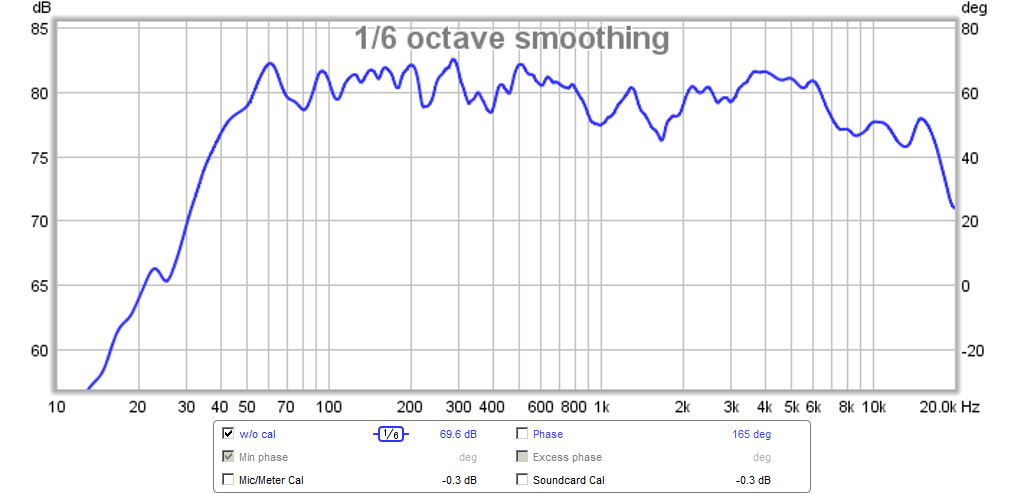
Here is the with mic calibration and without mic calibration file on sound card:
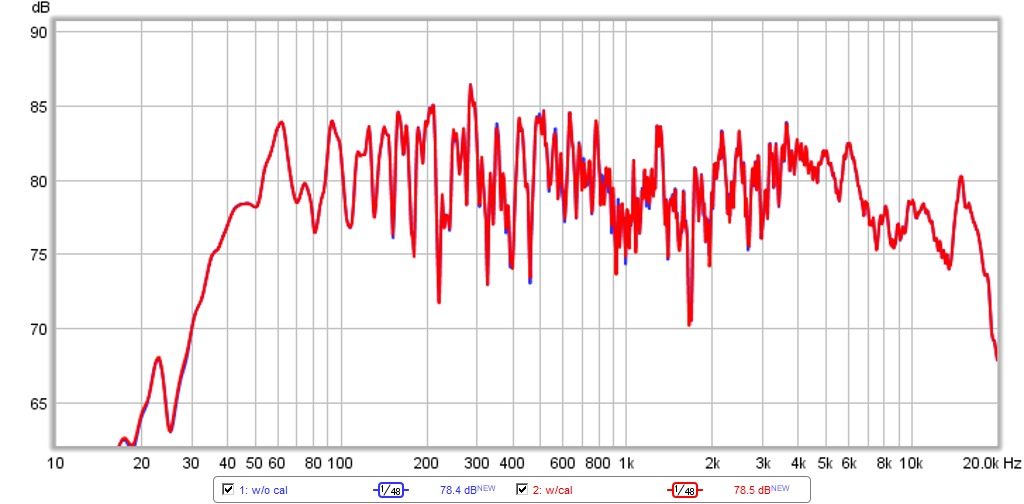
Here is impulse and step response:
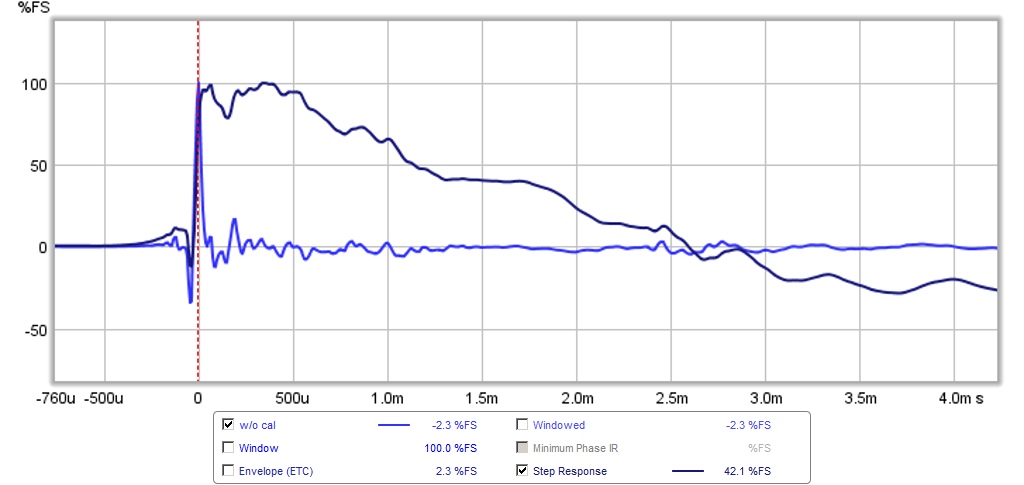
Here is a 1200Hz square wave as recorded with Audacity and using same USB mic:
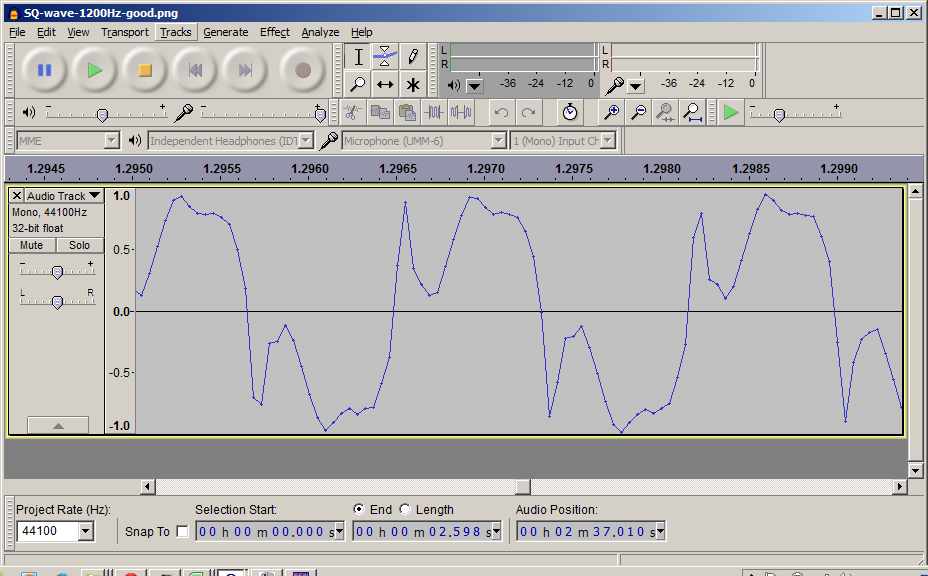
Here is HD at 90dB and 1m:
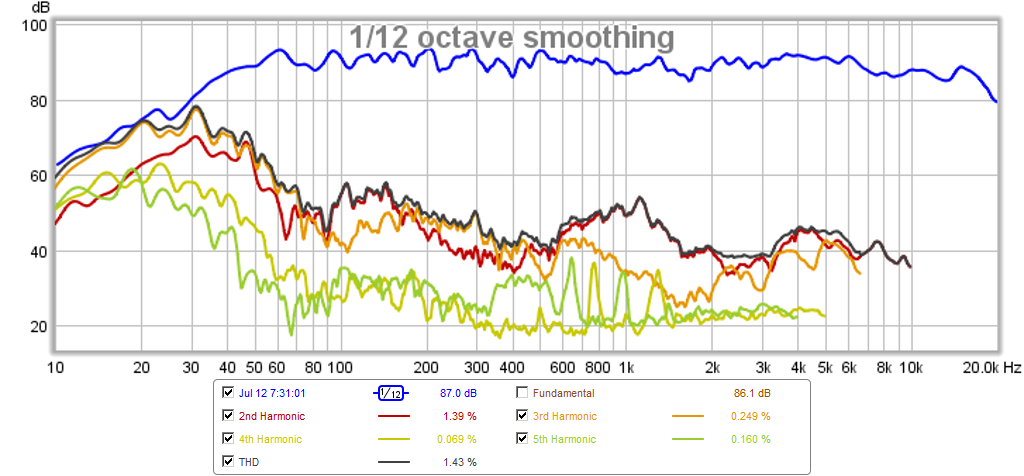
Attached are some sound clips of acoustic guitar that I think sounds exceptionally good. Rename to mp3 in order to listen. Attached is also the IR .wav file renamed as .asc.
Without touching any DSP setting, I moved the speaker out into the main rec room about 6x bigger (50 ft deep, 35 ft wide, irregular shaped with carpet and furniture, same 8ft ceiling. I placed a sofa cushion on floor between mic and speaker, draped curtains on tripod legs, and placed away from walls at 45 deg angle. Here are repeated measurements of frequency response, impulse and step response, and harmonic distortion referenced to 90dB at 1m. I checked for the effect of having the mic cal file included and not included in the sound card setup - it makes no difference probably because the sound skips the sound card as USB mic is used.
Frequency response is much better than I expected, looks like tweeter can use some more power or more efficient tweeter, but bass uniformity is excellent:

Here is the with mic calibration and without mic calibration file on sound card:

Here is impulse and step response:

Here is a 1200Hz square wave as recorded with Audacity and using same USB mic:

Here is HD at 90dB and 1m:

Attached are some sound clips of acoustic guitar that I think sounds exceptionally good. Rename to mp3 in order to listen. Attached is also the IR .wav file renamed as .asc.
Attachments
-
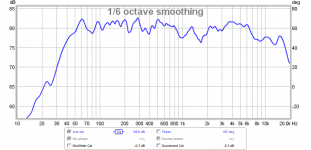 b-and-o-big-room-fr.png67.7 KB · Views: 706
b-and-o-big-room-fr.png67.7 KB · Views: 706 -
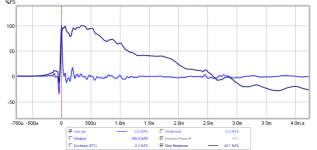 b-and-o-big-room-ir-sr.png62 KB · Views: 415
b-and-o-big-room-ir-sr.png62 KB · Views: 415 -
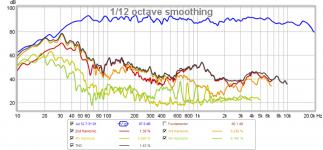 b-and-o-big-room-hd.png157.2 KB · Views: 409
b-and-o-big-room-hd.png157.2 KB · Views: 409 -
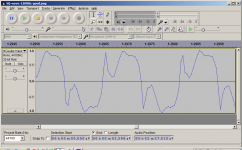 b-and-o-big-room-squarewave-1200Hz.png43.3 KB · Views: 404
b-and-o-big-room-squarewave-1200Hz.png43.3 KB · Views: 404 -
b-and-o-big-room-clip-0.asc1.7 MB · Views: 85
-
b-and-o-big-room-clip-1.asc1.7 MB · Views: 84
-
b-and-o-big-room-clip-2.asc1.8 MB · Views: 82
-
IR-bigroom-3.asc512 KB · Views: 80
-
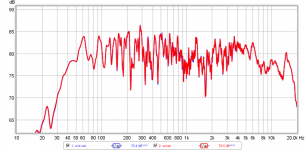 b-and-o-big-room-fr-cal-vs-nocal.png131.9 KB · Views: 417
b-and-o-big-room-fr-cal-vs-nocal.png131.9 KB · Views: 417
Last edited:
............. They do sound very nice - but quite a bit more busy with all the room reflections.
If OB fans saw this statement they would likely want to see some hard evidence; quite the opposite is what I find:
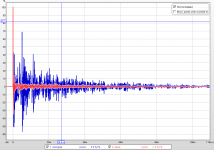
An omni microphone with flat response, and calibration data is more important than distortion measurements for low level signals.
Cross-Spectrum Labs has Dayton EMM-6 microphones with calibration data on/off axis; $90.
I picked up Behringer FCA610 with two preamplifiers and eight TRS outputs for $200. I have put it through its paces and all is well behaved; also has ASIO drivers. Only complaints are no on/off switch and that slightly higher outputs would work better with my Hafler Pro series amplifiers. Output levels would be quite robust with your favored amplifiers.
Is this from your TC9 Pluto clone setup? Very interesting that dipole has less reflections - how?
Hi, great way to experiment! Are you running the drivers with active DSP ? Or did you just add the 5in mid with a passive series cap? I have a 2-way with a 10F as mid/tweet and an RS225-8 as woofer. I could add a tweeter to that as a test. The open baffles is a great way to quickly test and it provides a very different sound. Maybe that is what you like too. Fun to play around with though.
Hi,
Nope, even simpler than that. The 5" is running full range, merely wired in series with the box speaker which has a standard second order two way between the 12" and HF1300. The KEF just has a capacitor, can't remember the value now but it comes in at about 10,000htz.
Basically, it seems the 5" adds a bit of texture to the upper bass and pushes the mids a bit forward. In fact, fixes what were the main weaknesses of the speaker🙂
No this is with data from http://www.diyaudio.com/forums/multi-way/269936-cardioid-sum-monopole-dipole-speakers.html
Dipoles smoke monopoles in department of early reflections; for potential increased front wall reflection the attenuation of sidewall, floor, and ceiling reflections provides significant overall benefits. You should study Linkwitz for dipole behavior in reflective spaces.
With my Pluto clones best imaging in my space is with speakers well away from walls with 4-5ft listening triangle. With LXmini clones I get great imaging with same set up, but can also open listening triangle up to >8ft with great imaging. In my space this requires speakers placed closer to sidewalls and to front wall. With LXmini it is still omni <700Hz, but most of meat for localization/imaging happens in 500Hz-4kHz bandwidth for timing cues; intensity cues overlap this, and is likely why comb filtering with high crossed tweeters is seldom an issue for most listeners with most speakers of such ilk.
My cardioid is strunning; I've got a recording of a musician with gravel in his voice that I've heard outdoors playing acoustic guitar in quiet backyard; The realism of his voice listening with the cardiod set up shames my Pluto and LXmini clones. I'm still pondering on getting similar performance with just a few more dB of SPL.
Yes, I'm glad you've figured out REW with RTA and signal generator; very good approach overall. Confirmation with normal v reverse polarity null with good windowing is nice to do as well.
More on calibration file usage. Your UMM-6 is relatively flat; flatter than what you are currently targeting thus far. Here is your B-TC9FD loaded solo three times into REW; short windows without smoothing. 1) is calibration applied in both microphone and soundcard fields. 2) is calibration in microphone field only. 3) is with calibration cleared completely:
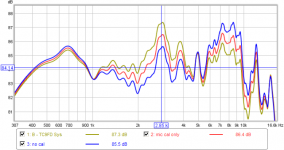
Dipoles smoke monopoles in department of early reflections; for potential increased front wall reflection the attenuation of sidewall, floor, and ceiling reflections provides significant overall benefits. You should study Linkwitz for dipole behavior in reflective spaces.
With my Pluto clones best imaging in my space is with speakers well away from walls with 4-5ft listening triangle. With LXmini clones I get great imaging with same set up, but can also open listening triangle up to >8ft with great imaging. In my space this requires speakers placed closer to sidewalls and to front wall. With LXmini it is still omni <700Hz, but most of meat for localization/imaging happens in 500Hz-4kHz bandwidth for timing cues; intensity cues overlap this, and is likely why comb filtering with high crossed tweeters is seldom an issue for most listeners with most speakers of such ilk.
My cardioid is strunning; I've got a recording of a musician with gravel in his voice that I've heard outdoors playing acoustic guitar in quiet backyard; The realism of his voice listening with the cardiod set up shames my Pluto and LXmini clones. I'm still pondering on getting similar performance with just a few more dB of SPL.
Yes, I'm glad you've figured out REW with RTA and signal generator; very good approach overall. Confirmation with normal v reverse polarity null with good windowing is nice to do as well.
More on calibration file usage. Your UMM-6 is relatively flat; flatter than what you are currently targeting thus far. Here is your B-TC9FD loaded solo three times into REW; short windows without smoothing. 1) is calibration applied in both microphone and soundcard fields. 2) is calibration in microphone field only. 3) is with calibration cleared completely:

Hmm... I get virtually no difference (maybe <0.5dB) between with cal on both vs mic only:

Note this is with the UMM-6 mic attached and working. If you don't actually have a mic, it may apply the filter twice as you are showing. With mic plugged in, the input sound card is bypassed. Do you have a USB mic plugged in? I assume you are using your usual analog input sound card and XLR mic.

Note this is with the UMM-6 mic attached and working. If you don't actually have a mic, it may apply the filter twice as you are showing. With mic plugged in, the input sound card is bypassed. Do you have a USB mic plugged in? I assume you are using your usual analog input sound card and XLR mic.
@ xrk971
Hi, did you miss my BTL measuring circuit in Post #185 ? It will do what you asked about 🙂
If you have any questions, just ask 😉
Hi, did you miss my BTL measuring circuit in Post #185 ? It will do what you asked about 🙂
If you have any questions, just ask 😉
xrk971,
Thanks sharing from bigger room, sound clips are really nice, not bad sound track a live recording played on OB in live room : )
Looking our IR-wav from big room compared IR-2 and smoothed 1/12 has now eleminated a excess 540º phase turn from 700Hz area and down and seems at least 50% improvement on excess phase turn in 900-3500Hz area.
Barleywater,
Thanks taking time post and share your great knowledge and tips.
Thanks sharing from bigger room, sound clips are really nice, not bad sound track a live recording played on OB in live room : )
Looking our IR-wav from big room compared IR-2 and smoothed 1/12 has now eleminated a excess 540º phase turn from 700Hz area and down and seems at least 50% improvement on excess phase turn in 900-3500Hz area.
Barleywater,
Thanks taking time post and share your great knowledge and tips.
@ xrk971
Hi, did you miss my BTL measuring circuit in Post #185 ? It will do what you asked about 🙂
If you have any questions, just ask 😉
Thanks, I saw that - but am pressed for time so wiring up a bunch of resistors is still going to take some time. I did my big room experiment to see if things improved because that was a quick test. I will let you know of I have questions.
- Status
- Not open for further replies.
- Home
- Loudspeakers
- Multi-Way
- "Filler" driver ala B&O
